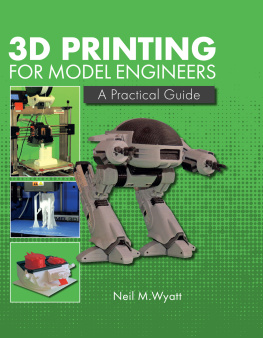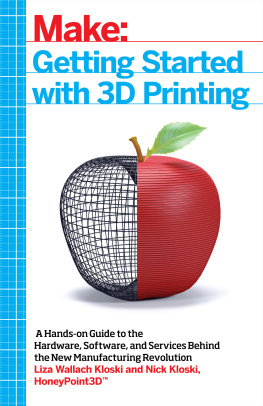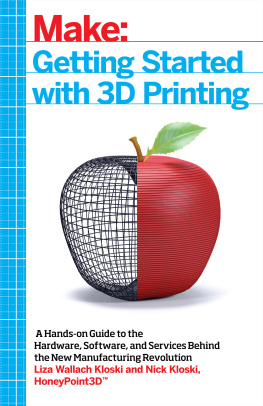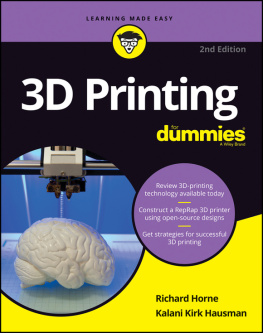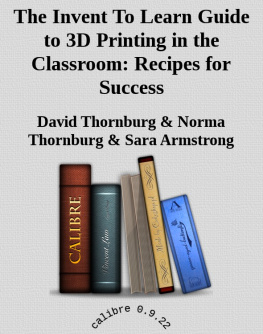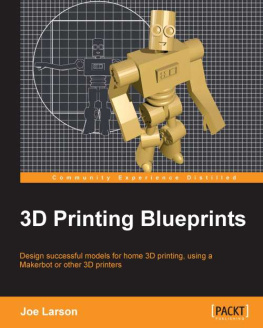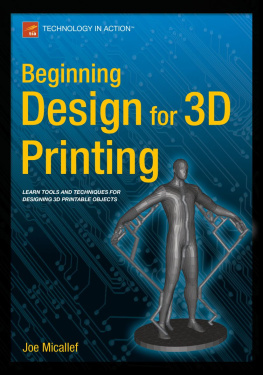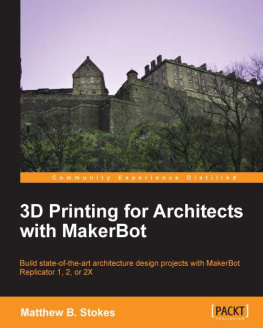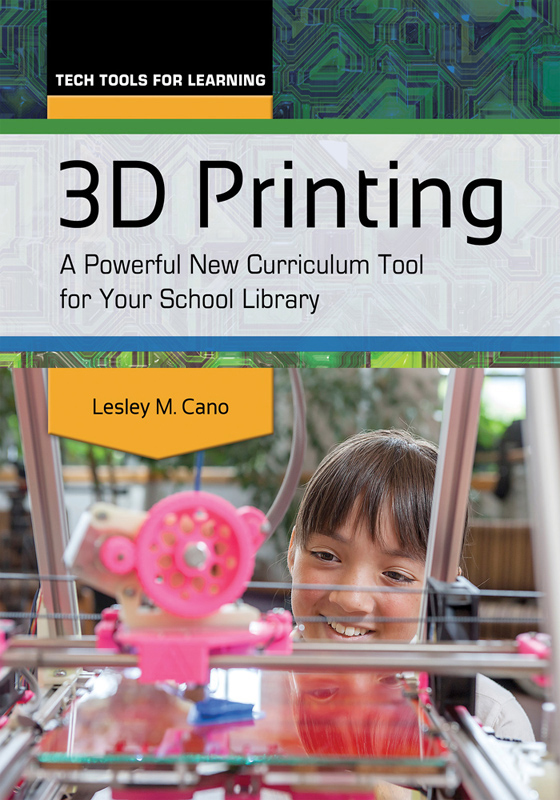3D Printing
Recent Titles in the Libraries Unlimited
Tech Tools for Learning Series
The Networked Library: A Guide for the Educational Use of Social Networking Sites
Melissa A. Purcell
Bookmarking: Beyond the Basics
Alicia E. Vandenbroek
School Library Infographics: How to Create Them, Why to Use Them
Peggy Milam Creighton
3D Printing: A Powerful New Curriculum Tool for Your School Library
Lesley M. Cano
Copyright 2015 by Lesley M. Cano
All rights reserved. No part of this publication may be reproduced, stored in a retrieval system, or transmitted, in any form or by any means, electronic, mechanical, photocopying, recording, or otherwise, except for the inclusion of brief quotations in a review, without prior permission in writing from the publisher.
Library of Congress Cataloging-in-Publication Data
Cano, Lesley M.
3D printing : a powerful new curriculum tool for your school library / Lesley M. Cano.
pages cm.(Tech tools for learning)
Includes bibliographical references and index.
ISBN 978-1-61069-977-8 (paperback) ISBN 978-1-61069-978-5 (ebook) 1. School librariesActivity programs. 2. Three-dimensional printing. 3. School librarian participation in curriculum planning. I. Title. II. Title: Three D printing.
Z675.S3C194 2015
027.8dc232015012916
ISBN: 978-1-61069-977-8
EISBN: 978-1-61069-978-5
191817161512345
This book is also available on the World Wide Web as an eBook.
Visit www.abc-clio.com for details.
Libraries Unlimited
An Imprint of ABC-CLIO, LLC
ABC-CLIO, LLC
130 Cremona Drive, P.O. Box 1911
Santa Barbara, California 93116-1911
This book is printed on acid-free paper 
Manufactured in the United States of America
AASL Standards for the 21st-Century Learner excerpted from Standards for the 21st-Century Learner by the American Association of School Librarians, a division of the American Library Association, copyright 2007 American Library Association. Available for download at www.ala.org/aasl/standards. Used with permission.
Next Generation Science Standards (Next Generation Science Standards are a registered trademark of Achieve. Neither Achieve nor the lead states and partners that developed the Next Generation Science Standards were involved in the production of, and does not endorse, this product.)
Common Core Standards Copyright 2010. National Governors Association Center for Best Practices and Council of Chief State School Officers. All rights reserved.
, Tinkercad, 123D Design screen shots reprinted with the permission of Autodesk, Inc.
, 3DTin screenshots reprinted with the permission of TeamUp Technologies, Inc.
To Mel, for her unflagging optimism and enthusiasm.
To Bob, Olivia and BJ, and Paula, for their support and encouragement.
And to Noah, Olivia, and Gabrielle, just for being.
Contents
I would like to thank a few people who have made my foray into 3D printing a little easier and a lot more successful than it would have been without them. First and foremost, I would like to thank Matt Brown, and Selena Ozuna, past and present administrators of Remynse Elementary in Arlington, Texas. They have both been champions for my school library program and are two of my strongest supporters.
When I first approached Matt with the idea of creating a makerspace in our school library, he didnt think twice before responding with a resounding yes. He enabled me to create a library that truly has transformed the way our students learn. He not only supports me as a librarian, he provides me with the challenge I need to reach beyond my comfort zone as a leader and encourages me to think outside of the box. I appreciate that both Matt and Selena recognize the power of a strong school library program and the difference school librarians can make.
Thanks also to Julie Moore, Library Media Services Coordinator extraordinaire. Above all, a school library program needs a strong leader who is passionate about the power of school libraries and who puts the good of students above all else, and thats exactly what Julie does. She advocates relentlessly for school libraries and her passion keeps me moving forward to provide 21st-century learning opportunities for students every day. Her indefatigable work and leadership are inspirational.
Much thanks to the faculty and staff at Remynse Elementary for their words of encouragement. Writing a book can be an arduous process, and knowing they were behind me made all the difference. Much gratitude and appreciation goes to Katy OConnell, for her extra helping of assistance, support, and encouragement.
Most of all, I need to thank the students at Remynse Elementary. The day we took our first 3D printer out of the box, a student told me with tears in his eyes that he never thought he would get to see a 3D printer in real life, let alone get to use one. Now, that same student proudly displays several 3D printed objects of his own design in the library. This student, like each of my students, has displayed enthusiasm and determination in learning new things, and patience with me as we have learned together.
D o you get excited about discovering new ways your library can impact student achievement and transform how your students learn? What if it involved technology so advanced that it not only is currently being used in a variety of fields to change the lives of people around the world but also is readily available to your K12 students? Welcome to the world of 3D modeling and printing!
3D modeling and printing can open doors for critical thinking, problem solving, and creativity in students and can be a catalyst for dynamic and engaging educational experiences. 3D modeling and printing has given me the opportunity to witness a transformation in student thinking. Students, including those who had become disenchanted with school, are now excited about learning and love coming to the library!
Two years ago, 3D modeling and printing were not on my radar when I was thinking of how I could better reach students through the power of the school library. Although I love technology and am fascinated by how technology engages students, I have never considered myself to be particularly proficient at figuring technology out, and frankly, I was a little unsure if I would be able to learn 3D modeling and printing so I could teach it to my students. The good news is, I didnt have to.
You dont have to be adept at 3D modeling and printing in order to get it started in your school library. I learned 3D modeling and printing right along with my students. They loved seeing me learning right alongside them and enjoyed it immensely when they could teach me a thing or two.
I became interested in 3D printing because I am always looking for ways to keep the library relevant. I teach at a Title I school where almost 90 percent of students are low income and English is a second language to many of our students. I strongly feel it is my duty to expose students to the newest technologies so they will have skills to compete for college and careers when they are ready. This encourages me to continue to think of what and how I can reach students in a new and engaging way.
When I first read about 3D printing, I had a hard time imagining exactly what it was. I read about a high school utilizing 3D printing as part of an engineering program. My first thought was, Wow! Thats amazing that high school students are doing this! My second thought was, Why cant my elementary students do this? After a lot of research and talking with many people about using 3D printing in schools, I gathered my notes and went in to speak with my principal. I am lucky to work for a principal who not only loves technology, but also appreciates how technology can transform learning and teaching. He approved a grant I wrote through my districts Instructional Technology department and through this grant I received robotics kits and a 3D printer for my librarys makerspace.



